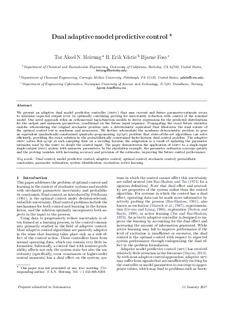| dc.contributor.author | Heirung, Tor Aksel N. | |
| dc.contributor.author | Ydstie, Birger Erik | |
| dc.contributor.author | Foss, Bjarne Anton | |
| dc.date.accessioned | 2018-04-04T07:54:40Z | |
| dc.date.available | 2018-04-04T07:54:40Z | |
| dc.date.created | 2017-12-11T13:59:44Z | |
| dc.date.issued | 2017 | |
| dc.identifier.citation | Automatica. 2017, 80 340-348. | nb_NO |
| dc.identifier.issn | 0005-1098 | |
| dc.identifier.uri | http://hdl.handle.net/11250/2492494 | |
| dc.description.abstract | We present an adaptive dual model predictive controller (dmpc) that uses current and future parameter-estimation errors to minimize expected output error by optimally combining probing for uncertainty reduction with control of the nominal model. Our novel approach relies on orthonormal basis-function models to derive expressions for the predicted distributions for the output and unknown parameters, conditional on the future input sequence. Propagating the exact future statistics enables reformulating the original stochastic problem into a deterministic equivalent that illustrates the dual nature of the optimal control but is nonlinear and nonconvex. We further reformulate the nonlinear deterministic problem to pose an equivalent quadratically-constrained quadratic-programming (qcqp) problem that state-of-the-art algorithms can solve efficiently, providing the exact solution to the probabilistically constrained finite-horizon dual control problem. The adaptive dmpc solves this qcqp at each sampling time on a receding horizon; the adaptation is a result of updating the parameter estimates used by the dmpc to decide the control input. The paper demonstrates the application of dmpc to a single-input single-output (siso) system with unknown parameters. In the simulation example, the parameter estimates converge quickly and the probing vanishes with increasing accuracy and precision of the estimates, improving the future control performance. | nb_NO |
| dc.language.iso | eng | nb_NO |
| dc.publisher | Elsevier | nb_NO |
| dc.rights | Attribution-NonCommercial-NoDerivatives 4.0 Internasjonal | * |
| dc.rights.uri | http://creativecommons.org/licenses/by-nc-nd/4.0/deed.no | * |
| dc.title | Dual adaptive model predictive control | nb_NO |
| dc.type | Journal article | nb_NO |
| dc.type | Peer reviewed | nb_NO |
| dc.description.version | acceptedVersion | nb_NO |
| dc.source.pagenumber | 340-348 | nb_NO |
| dc.source.volume | 80 | nb_NO |
| dc.source.journal | Automatica | nb_NO |
| dc.identifier.doi | 10.1016/j.automatica.2017.01.030 | |
| dc.identifier.cristin | 1525699 | |
| dc.description.localcode | © 2017. This is the authors’ accepted and refereed manuscript to the article. Locked until 30.3.2019 due to copyright restrictions. This manuscript version is made available under the CC-BY-NC-ND 4.0 license http://creativecommons.org/licenses/by-nc-nd/4.0/ | nb_NO |
| cristin.unitcode | 194,63,25,0 | |
| cristin.unitname | Institutt for teknisk kybernetikk | |
| cristin.ispublished | true | |
| cristin.fulltext | postprint | |
| cristin.qualitycode | 2 | |

